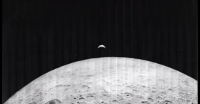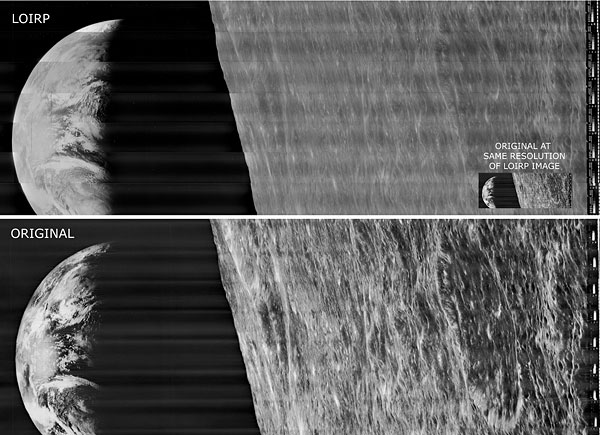How NASA’s Lunar Orbiter photographs were restored in high definition
posted Wednesday, July 16, 2014 at 4:34 PM EDT

Back in the 1960s, NASA ran the Lunar Orbiter program, whose mission was to find viable landing sites for future Apollo missions -- including that of Apollo 11 in 1969, which took the first humans to the Moon. Between 1966 and 1967, NASA managed to map 99% of the Moon's surface during the five successive Lunar Orbiter missions.
Each of the Lunar Orbiter spacecraft was equipped with a two-lens camera that took detailed photographs of the Moon's surface. While one lens was taking pictures of a wider area, the other one zoomed in on a smaller crop for more detail. The pictures were captured on 70mm film which, in theory, provided a huge amount of detail.
However, back then it was not an option to have the spacecraft return to Earth -- instead, they were each crashed on the Moon's surface after their individual missions were over. So in order to get the photographs back to NASA, each Lunar Orbiter came with its own film development module as well as scanner that converted the images into signals that could then be transmitted down to Earth.

Back on Earth, the images were then stored onto a total of about 1,500 tapes (yes, there were no hard disks or anything like that back in the sixties) and later published in the media. This allowed not only NASA but also the public to see pictures of the Lunar Orbiter missions shortly after they were taken -- which was quite a technological achievement for the time.
When the tapes and the machines that could read it were no longer used, they were stowed away and eventually forgotten. It wasn't until the early 2000s that a group of enthusiastic individuals decided to repair the original tape drives and restore the data on the original Lunar Orbiter tapes. The goal was to digitize the images in much higher quality than was possible back in the sixties, with the help of 21st century technology.
The video below tells the story of the Lunar Orbiter Image Recovery Project -- a story we've been fascninated with before -- of how it got hold of the original tapes and tape readers, and how it re-purposed a former McDonald's restaurant (aptly nicknamed "McMoon's") into their base of operations. And, of course, it shows some of the photos that the LOIRP was able to restore from the original tapes -- in high definition.
The video is part of a series created by the Hillman Photography Initiative of the Carnegie Museum of Art, which also covers the story of Andy Warhol's first digital creations in another episode. The whole series, and much more, can be found on the Carnegie Museum of Art's Vimeo page.
(via Gizmodo Reframe)